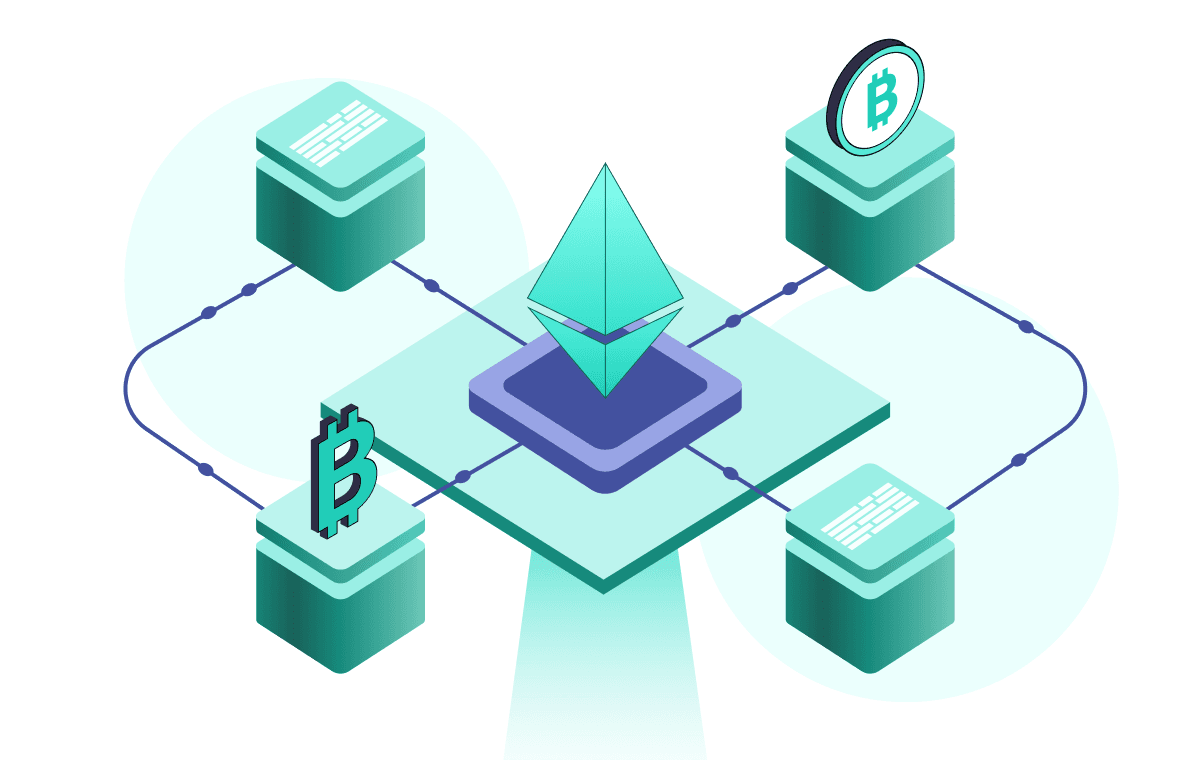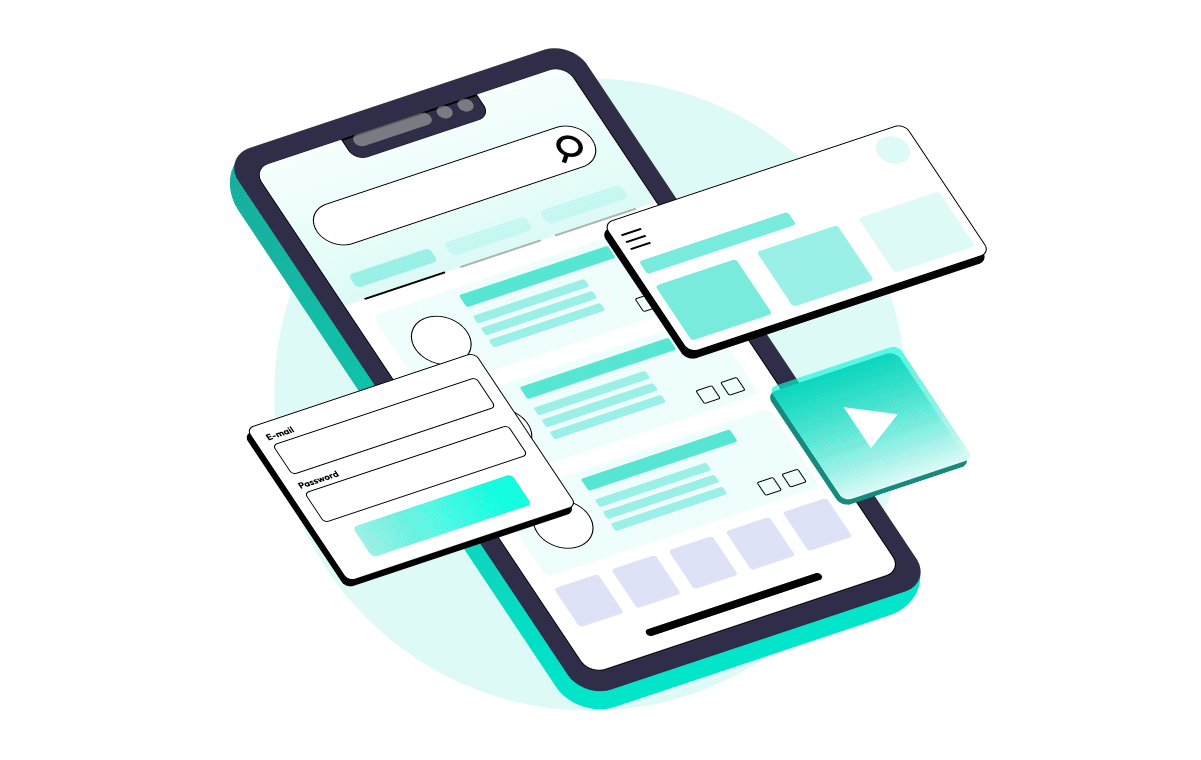Updated Feb 21, 2025 15 min read
A Comprehensive Guide: How to Test Blockchain Applications
This article will discuss blockchain testing, clarify its purpose, review methods for testing blockchain applications, and highlight the main challenges software testers face when assessing these applications.

Would a simpler method exist to execute transactions without engaging with online wallets, banks, and third-party applications? Blockchain technology makes this achievable. We are introducing cryptocurrencies, a digital or virtual currency based on blockchain technology, to simplify transactions. Fundamental attributes such as transparency, precision, and authentication of individual agreements and transactions unify all successful blockchain solutions. According to a report, the global blockchain technology market was valued at USD 10.02 billion in 2022. Looking ahead, experts forecast a remarkable annual growth rate of 87.7% from 2023 to 2030, promising to transform the global landscape of blockchain technology significantly.
This article will explore blockchain testing, define its purpose, examine how to test blockchain applications with the various testing methodologies and address the primary challenges software testers encounter when evaluating blockchain applications.
What is Blockchain Testing?
Blockchain testing systematically assesses various functional elements within a blockchain system, such as smart contracts, blocks, mining, transactions, wallets, and more. In contrast to conventional software testing, blockchain testing entails a comprehensive evaluation of multiple components to enhance the overall quality of a blockchain deployment, ranging from system performance to security measures.
The primary goal is to confirm the proper operation of the blockchain system and uncover any potential issues or risks. A critical aspect is to uphold the integrity and immutability of data stored on the blockchain. This verification process ensures that the recorded data on the blockchain remains unaltered and secure, leveraging the core attributes of blockchain technology to deliver a trusted and transparent ledger.
Why Choose Blockchain Technology?
When considering blockchain technology, imagine a hotel temporarily holding a guest's credit card for the total stay amount, removable only after check-out. Is this precaution necessary? Absolutely. It addresses the inherent lack of trust between customers and businesses. Blockchain streamlines financial transactions by eliminating the need for unwarranted fund holds and constant verification checks from central banks. Likewise, companies' reliance on SWIFT transfers can be mitigated in import and export operations by implementing blockchain's decentralized ledger system. Through cryptographic security measures, transactions can be securely stored and payments processed in real time, removing the necessity for traditional banking guarantees until the importer receives goods.
The global blockchain technology market is experiencing rapid growth. Valued at approximately USD 31.28 billion in 2024, it is projected to reach USD 825.93 billion by 2032, with a Compound Annual Growth Rate (CAGR) of 52.8% during the forecast period. This statistic highlights the increasing adoption of blockchain technology across industries and underscores its exponential growth.
Blockchain is a highly secure digital ledger structured in interconnected blocks with robust encryption protocols. Initially devised for digital currencies like Bitcoin, blockchain has evolved to encompass recording diverse transactions beyond finance, encapsulating assets of substantial value (you can check out our article on mobile UI testing for a more detailed guide).
Testing Types of Blockchain Applications
Functional testing, integration testing, performance testing, and security testing play essential roles in maintaining the dependability and effectiveness of blockchain applications. Each type of testing is designed to address distinct aspects of the blockchain system to ensure its durability and smooth functionality.
Functional Testing
Functional testing is crucial in evaluating the business context and efficiency of use-case scenarios in blockchain applications. Critical considerations for conducting functional testing include:
- Block size: Each block in a blockchain has a memory size of megabytes. Testers must focus on scenarios where transaction data stored in each block exceeds 1MB, determine appropriate encryption techniques to link these blocks, and handle other complex scenarios.
- Data transmission: It is essential to test for data loss during transmission between blocks since the fundamental structure of blockchain revolves around data transactions and security.
- Adding a block: It is critical to evaluate the blocks added to the chain, as they cannot be altered once incorporated.
- Smart contract: Ensuring that all parties involved in transactions adhere to the rules established by the smart contract promotes the smooth operation of the blockchain application.
- Node testing: Independent testing of all diverse nodes in the network is necessary to verify their seamless functionality.
Integration Testing
How to test blockchain applications for integration testing? Integration testing is crucial for blockchain, an ecosystem comprising various components that must be interconnected. Testing the different APIs associated with these components for compatibility is essential. The integration process involves testing the compatibility of these APIs and verifying that all blockchain elements, including nodes and external interfaces, interact correctly and perform as expected. Accurate and consistent data exchange between these integrated components is essential to maintain the system's integrity.
Performance Testing
Performance testing in blockchain is significant in assessing the number of transactions, transaction sizes, and the performance of blocks or applications intended for deployment. It involves evaluating network capabilities, transaction processing speed, user interfaces, system interfaces, and responses from smart contracts. Identifying hardware and software bottlenecks before deployment is crucial, as is understanding the cost implications for running applications in different environments.
Security Testing
Security testing for blockchain applications is imperative to identify vulnerabilities, test authorization, and authentication systems, and ensure protection against potential attacks. It encompasses confidentiality, integrity, availability, and other critical aspects. It is especially crucial in detecting identity layer hacks and ensuring the security of ongoing transactions during an attack. Testing components such as wallet signature methods, private keys, consensus algorithms, and platform dependencies are critical aspects of security testing. Additionally, the irreversible nature of fraudulent transactions in blockchain underlines the importance of robust security testing.
Functional testing comprehensively assesses the business logic and data integrity of blockchain applications. Integration testing guarantees seamless communication among different blockchain elements. Performance testing evaluates the system's performance under diverse conditions, while security testing strengthens the application against potential risks. Together, these thorough testing blockchain applications approach to boost the reliability and security of blockchain applications. You can explore our blockchain testing services to learn more about how we can assist with your blockchain project.
Blockchain Testing Tools
The following tools are essential for testing blockchain applications to ensure their proper functionality:

Reasons for Businesses to Embrace Blockchain Testing
By 2026, the business value added by blockchain is expected to exceed USD 360 billion, indicating significant integration of blockchain solutions across various sectors. The market's growth is primarily fueled by increased demand for improved supply chain transparency across various sectors, the need to address risks and complexities, and the enhanced efficiency observed in deploying blockchain solutions. Moreover, the rise of the IoT, blockchain technology, and government initiatives are driving the profit potential for blockchain as a service provider. Due to the escalating threat posed by sophisticated cyber-attacks, businesses are turning to blockchain technology as a security measure. Consequently, the imperative arises for businesses to embrace blockchain testing.
It is therefore paramount for testers to acquire the proficiency to evaluate blockchain-powered applications equipped with extensive deployment and integration capabilities. This endeavor serves the following purposes:
Ensuring the establishment of a secure infrastructure for your enterprise.
Rectifying shortcomings within a decentralized ledger.
Validating all components of the blockchain system.
Crafting a functional blockchain ecosystem.
Safeguarding blockchain technology and its associated infrastructure.
Diminishing the risks associated with introducing new applications and streamlining the revalidation process.
Businesses should use blockchain testing to mitigate increasing cybersecurity risks and safeguard the confidentiality and reliability of their blockchain applications.
Guidelines for Conducting Blockchain Testing
This section delves into how to test blockchain applications effectively, encompassing crucial phases to ensure the security and operability of blockchain networks and applications. To meticulously plan and strategize blockchain testing, it is imperative to address the following pivotal aspects:
- Testing objectives: Clearly outline the objectives of the testing endeavor. Identify the specific functionalities, performance expectations, and security protocols requiring validation.
- Testing scope: Define the parameters of the blockchain testing initiative, including how to test blockchain functionalities effectively. Delineate the blockchain system components to be tested, encompassing smart contracts, consensus algorithms, data storage, and network connectivity.
- Testing techniques: Select the appropriate testing techniques, including functional testing, performance testing, security testing, and compatibility testing. Opt for testing methodologies and approaches commensurate with the blockchain system's characteristics.
- Testing tools and environments: Choose suitable tools and environments for blockchain tests. Consider dedicated tools for smart contract testing, blockchain emulation, and performance assessment. Establish test environments that faithfully replicate the production setting.
- Test data and environments: Specify the prerequisites for test data and ensure ample test data is available for realistic scenarios. Develop or acquire test datasets covering diverse transaction types, user accounts, and network conditions.
- Resource allocation: Allocate essential resources, including proficient testers, blockchain specialists, and appropriate test infrastructure. Define the roles and responsibilities of testing team members, fostering effective collaboration among developers, testers, and blockchain experts.
- Blockchain-specific considerations: Factor in the distinctive elements of blockchain technology. Familiarize yourself with the underlying blockchain platform, consensus mechanisms, encryption methodologies, and smart contract execution. Address blockchain-specific testing challenges like limited testing tools, intricate smart contracts, and scalability issues.
- Test execution and reporting: Implement the designated test cases and document the outcomes. Monitor the advancement of testing activities and document any identified issues or defects. Compile comprehensive test reports offering insights into the test coverage, results, and suggestions for enhancement.
Adhering to a well-defined testing plan and strategic framework can guarantee thorough and efficient testing of their blockchain-based systems. This approach aids in identifying and mitigating potential risks, validating the dependability and security of blockchain solutions, and ensuring successful deployment in real-world scenarios.

Want to improve your product? Contact us today, and let's start testing tomorrow!
Challenges in Testing Blockchain Technology
Organizations face unique obstacles in blockchain testing that warrant meticulous attention to provide thorough testing and reliable blockchain solutions. These challenges span various facets and may encompass:
Scarcity of testing tools and frameworks: Unlike conventional software testing, specialized tools and frameworks for testing blockchain are limited. This scarcity can make it challenging to find appropriate tools tailored to meet the specific requirements of blockchain testing, such as testing smart contracts or distributed consensus algorithms.
Complexity of smart contracts: Smart contracts play a pivotal role in blockchain systems, and testing their functionality and security can be intricate. These contracts often entail sophisticated business logic and the handling of diverse edge cases. Testing such contracts requires a profound understanding of the underlying blockchain platform and programming languages.
Insufficiency of test data: Acquiring ample test data can prove challenging in blockchain testing. Realistic test scenarios typically require substantial data, encompassing transaction records, user accounts, and network conditions. Generating such data can be time-consuming and resource intensive.
Adherence to regulatory compliance: Blockchain technology has specific regulatory mandates across various industries. Ensuring compliance with industry-specific regulations and standards introduces an added layer of complexity to blockchain testing. Organizations must verify that their blockchain solutions align with compliance standards and regulations.
Security vulnerabilities: Despite boasting inherent security features, blockchain systems are not impervious to vulnerabilities. Evaluating the security aspects of blockchain, such as identifying potential attack vectors, safeguarding private keys, and ensuring data privacy, is crucial. Comprehensive security assessments should be integrated into blockchain testing to unearth vulnerabilities and mitigate potential risks.
To effectively address these challenges, combining expertise in blockchain technology, specialized testing methods, and close cooperation among developers, testers, and blockchain specialists is crucial. By overcoming these hurdles, organizations can ensure their blockchain solutions' reliability, security, and robustness, thereby paving the way for this transformative technology's successful implementation and adoption.
Best Practices for Blockchain Testing
Incorporating best practices is imperative for the comprehensive and efficient testing of blockchain applications. This section delves into various suggested strategies that can significantly enhance the efficiency and quality of blockchain testing.
- Initiate testing early and consistently: Commence testing at the earliest stages of the development life cycle to detect and mitigate issues promptly. Implement continuous integration and testing methodologies to detect defects and uphold system stability.
- Validate end-to-end scenarios: Develop test cases encompassing end-to-end scenarios, including transaction inception, smart contract execution, validation processes, and consensus mechanisms. Evaluate diverse user roles and interactions within the blockchain system for comprehensive test coverage.
- Prioritize security testing: Place significant emphasis on security testing to unveil vulnerabilities, potential attack routes, and risks. Rigorously assess authentication mechanisms, access controls, cryptography implementations, and other security facets of the blockchain system.
- Consider performance and scalability: Test the blockchain system's performance and scalability under varying load conditions. Measure transaction throughput, response times, network latency, and resource usage to ascertain the system's ability to accommodate anticipated transaction volumes.
- Integrate smart contract testing: Formulate specific test cases to verify smart contracts' functionality, accuracy, and security. To fortify their resilience, test diverse paths, conditions, and exceptional scenarios within smart contracts.
- Utilize realistic test data: Employ synthetic and real-world test data to replicate diverse scenarios and validate system behavior. Consider using anonymized or obscured data to adhere to data privacy regulations.
Adhering to best practices in blockchain testing ensures robust and reliable applications by focusing on early testing, comprehensive scenarios, security, performance, smart contract integrity, and realistic data.
Case Study: Enhancing Supply Chain Management Efficiency through Blockchain Testing
Our team is pleased to present our successful case study detailing how to do blockchain testing substantially improved supply chain management efficiency for a leading global logistics company. By executing thorough testing and deploying a blockchain solution, our client gained instant visibility, streamlined processes, and bolstered security measures, ultimately resulting in cost efficiencies and operational superiority.
Client: Global logistics corporation.
Challenge: Our client faced multiple challenges while trying to control its complex supply chain network effectively. Issues related to a lack of transparency, inefficiency in tracking the goods, and delays in document processing were common, further leading to higher costs and customer dissatisfaction.
Solution: Our team deployed a blockchain-driven supply chain management solution to tackle these obstacles. We conducted comprehensive testing of the blockchain application, focusing on functional, integration, performance, and security aspects. It encompassed validating smart contracts that govern transactions, ensuring smooth integration with existing systems, assessing system performance under varying loads, and identifying and addressing security vulnerabilities.
Results: The blockchain application was implemented following robust testing, transforming our client's supply chain operations. By leveraging blockchain technology, the client gained real-time visibility into goods movement across the entire supply chain. Automated smart contracts streamlined agreement execution, reducing manual processes and optimizing efficiency. Performance testing ensured the system's capability to manage peak loads, maintaining operational efficiency during high-traffic periods. Additionally, rigorous security measures safeguarded sensitive data and transactions, enhancing trust and reliability.
Key Takeaways: This successful case study showcases the transformative impact of blockchain testing in streamlining supply chain management. By integrating a blockchain solution and conducting thorough testing, our client experienced heightened transparency, cost reductions, and enhanced operational efficiency in their supply chain activities. It highlights the significance of leveraging blockchain technology and robust testing methodologies to tackle intricate business challenges and foster innovation.
Conclusion
Thorough testing of blockchain applications is essential to ensure their intended functionality, security, and optimal performance. Following the outlined procedures enables organizations to test their blockchain apps and prepare them for rigorous deployment. Remember that testing is an ongoing process, necessitating regular assessments to uphold security and performance standards. Whether you want to advance technology, infrastructure, software, or consulting, we’re here to help. If you have an idea and want to bring it to life, we’d be pleased to collaborate with you. Contact us today, and let’s explore how we can make your vision a reality.
Comments
There are no comments yet. Be the first one to share your opinion!
For 8 years, we have helped more than 200+ companies to create a really high-quality product for the needs of customers.
- Quick Start
- Free Trial
- Top-Notch Technologies
- Hire One - Get A Full Team
Was this article helpful to you?
Looking for reliable Software Testing company?
Let's make a quality product! Tell us about your project, and we will prepare an individual solution.
FAQ
Canary testing offers a proactive way to release updates, ensuring that potential problems are identified early and do not disrupt the entire user base. It’s an effective strategy for maintaining high software quality and user satisfaction.
Not quite! The term comes from the practice of coal miners using canaries to detect dangerous gases. In the same way, canary testing lets us release new features to a small group of users, like sending a “canary” into the system to spot issues before a full release.
Yes! Whether you're introducing new features, performance improvements, or infrastructure changes, canary testing is a versatile approach to ensure quality without impacting the entire user base.
The main benefit is risk mitigation. By releasing updates to a small group first, you minimize the chance of widespread issues and ensure a more stable, reliable experience for all users.
Factors such as the complexity of applications, size of the user base, available resources, frequency of releases, and risk tolerance levels should be considered when determining the appropriateness of canary testing for a given company or product.




